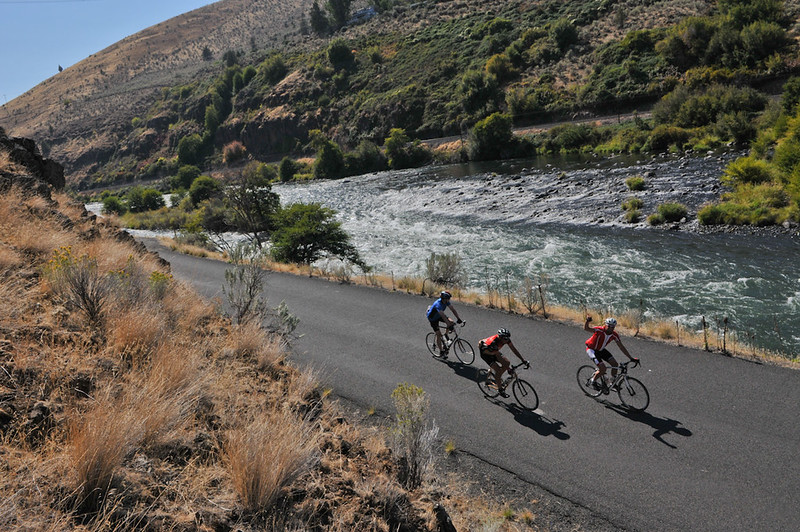
(Photos: J. Maus/BikePortland)
Portland’s 16th State Scenic Bikeway rolls through river canyons, sacred tribal fishing grounds and the small-town splendor that rural Oregon is known for. Travel Oregon and the Oregon Parks and Recreation Department announced the Sherar’s Falls Scenic Bikeway today.
Here’s the official map and route description:
Sherar’s Falls Scenic Bikeway traverses the strikingly scenic high desert canyon of northern Central Oregon, known as River Canyon Country. This 33-mile loop (with 1,700 feet of climbing) winds along the Deschutes River en route to the bikeway’s namesake, Sherar’s Falls, where the Confederated Tribes of Warm Springs fish for salmon just as they have for thousands of years — from wooden scaffolds using traditional dip nets and set nets.
Riders will follow a section of White River and pass White River Falls State Park, one of Oregon’s secret hideaways, where a short walk leads to views of the river’s 90-foot plunge over a basalt shelf.
The small, vibrant town of Maupin — and its walkable downtown, friendly locals, restaurants, lodging and camping — serves as the bikeway’s start and finish.
Advertisement
This ride is best enjoyed in spring and fall, as well as some mild winter days. In springtime, wildflowers dot the hillsides, including lupine bearing purple sprays and arrowleaf balsamroot with its pops of yellow. Come winter, Central Oregon can be a dry, temperate reprieve while the rest of the state shelters from rain. Tucked in the protective shadow of the Cascade Mountains, the region boasts 300 days of sunshine and less than six inches of rain per year.
And yes, it’s as good as it sounds. I had the pleasure of riding part of this loop (from Maupin to Tygh Valley) on day six of the 2014 Cycle Oregon ride. Riding along the Deschutes on the low-traffic BLM access road north of Maupin and stopping at Sherar’s Falls to watch the fishermen work on the scaffolds was a big highlight.
Oregon’s Scenic Bikeway program was created in 2008. Routes can be proposed by anyone and are then vetted by the State Parks Commission and judged for scenic quality and roadway conditions. Once a route is selected it receives special directional signage and marketing. The routes spur tourism-related economic activity for nearby towns and businesses. Browse maps, GPS files, hotel and services listings and much more at RideOregonRide.com or learn more about the scenic bikeway program on the State of Oregon website.
— Jonathan Maus: (503) 706-8804, @jonathan_maus on Twitter and jonathan@bikeportland.org
BikePortland is supported by the community (that means you!). Please become a subscriber or make a donation today.

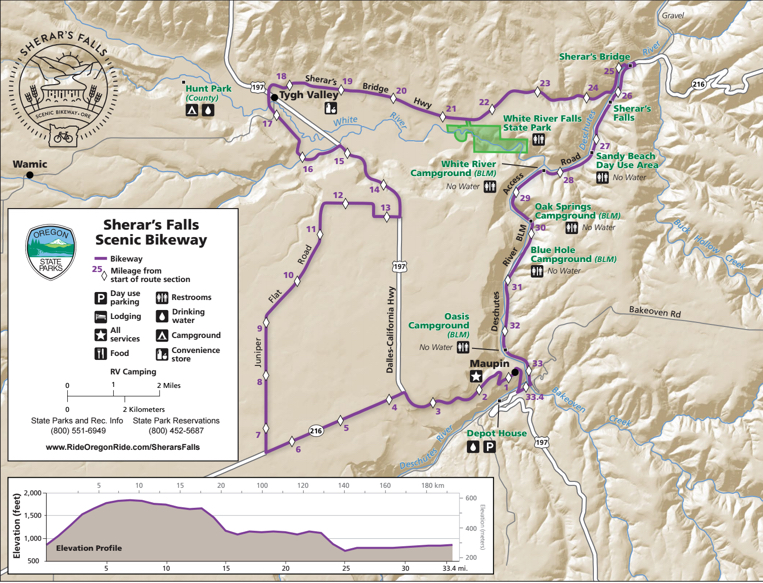
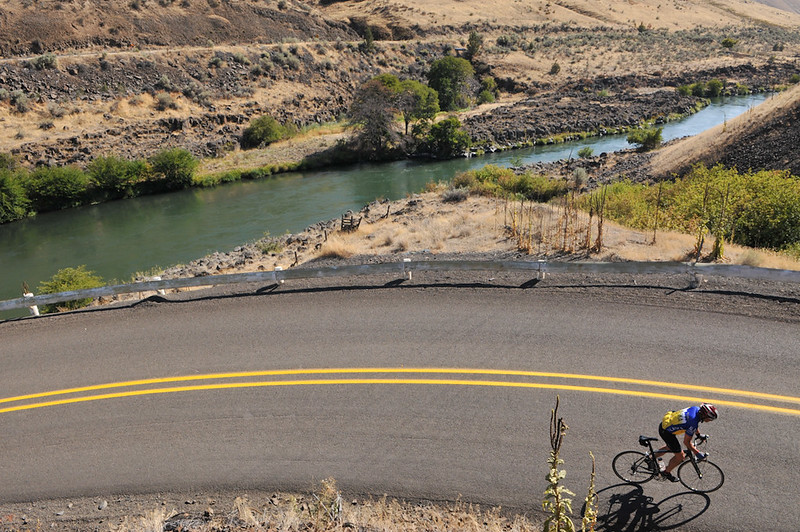
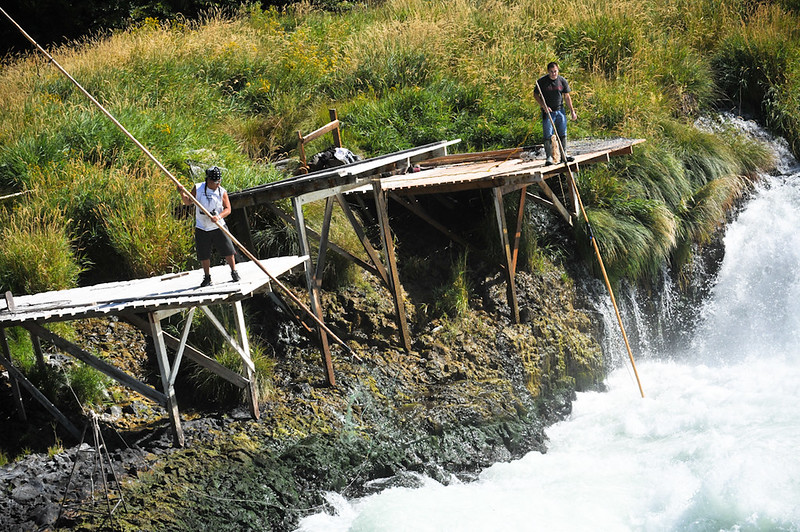
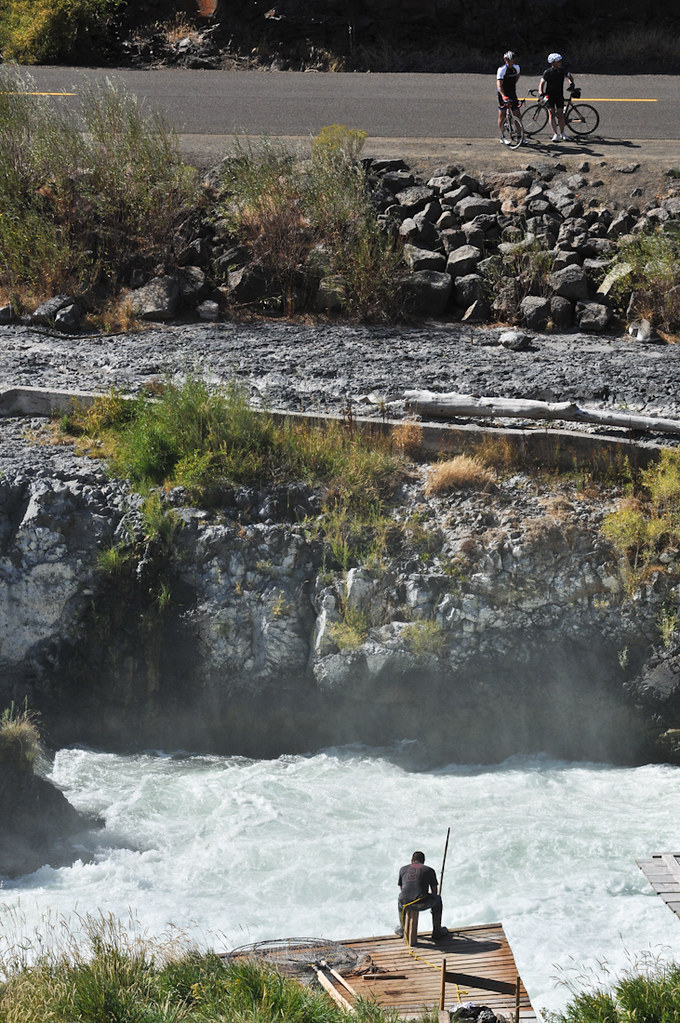
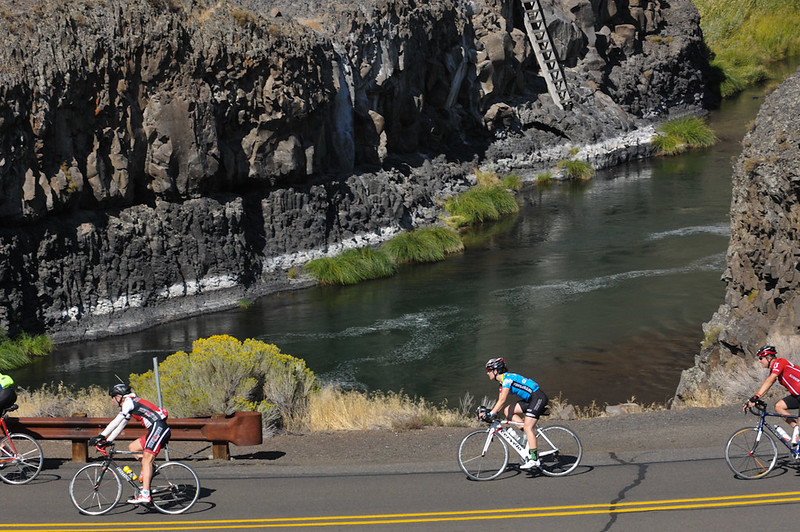
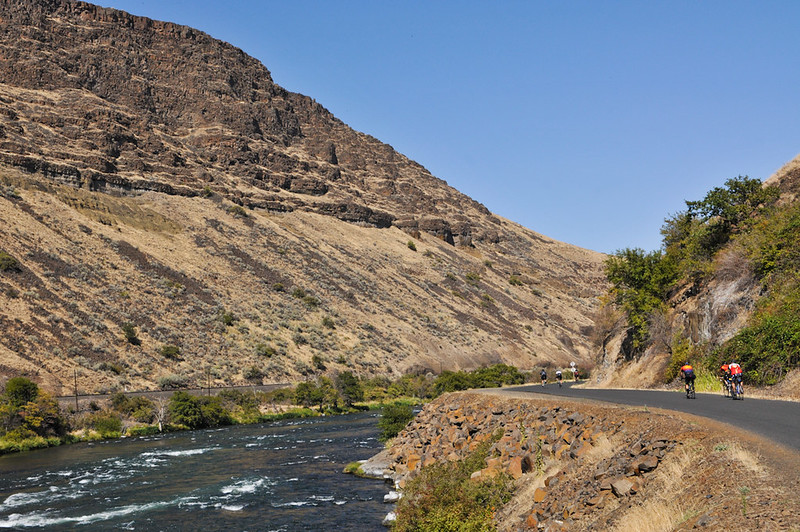


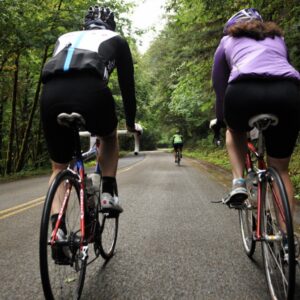
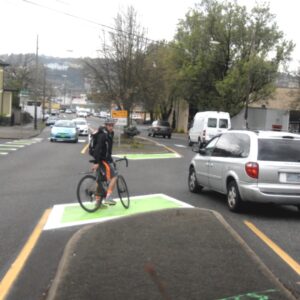
Thanks for reading.
BikePortland has served this community with independent community journalism since 2005. We rely on subscriptions from readers like you to survive. Your financial support is vital in keeping this valuable resource alive and well.
Please subscribe today to strengthen and expand our work.
Signs are cheap.
Did you want a protected bikeway through Maupin and Tygh Valley??
I for one have zero interest in recreational cycling on any facility that is not completely separated from motor vehicle traffic. Constantly watching my rear is not my idea of recreation. So it’s not just Adam, it’s all us “interested but concerned” potential cycling tourists.
Is it really so bad to have to deal with a couple of motorists per hour, which some portions of some of the scenic bikeways have? Even on urban/suburban off-street sidewalks (formerly bike paths), there are road crossings and such to deal with.
I think folks should give these things a whirl. I have found that the people in less-urbanized areas can be awfully nice, even when driving, and that can renew one’s faith in humanity. Not all of the scenic bikeways are joys to ride on, but some of them are wonderful, as are many places not in the system.
Not during rafting or Steelhead season.
Keri and I have ridden the scenic bike way along the Willamette River twice and found it very enjoyable. On some stretches it was so quiet, we could imagine a world without motor vehicles. Even the busy sections were pretty sedate by city standards.
Some of the scenic bikeways are quite nice, with only very light traffic. Others are completely insane. The “scenic bikeway” extending south from the Banks-Vernonia trail is a death trap as well as huge swaths of Highway 101.
Thanks for the nuanced perspective, I completely agree. I think there is a market out there (less than 2% of the tourist market, I’d guess, but still) that will ride on roads with light high-speed car traffic. This program is not completely useless, but it certainly only has a fraction of the potential market that biking separated from cars has.
However, even for that ~2% of humanity, think it’s reasonable to expect that a “scenic bikeway” will have low car traffic by default, and that the routes or sections that don’t will be clearly marked on the map. The idea that a rough road requires a “caution” sign on the map for the Wild Rivers scenic bikeway but that four miles on Highway 101 doesn’t just seems weird to me. http://www.oregon.gov/oprd/BIKE/docs/WildRiversMapandCue.pdf
Having driven much of the Sherar’s Falls route, I think the traffic levels are probably mostly fairly approachable to people who already bike some with high-speed traffic. I imagine the hills are huge going in and out of the Deschutes and White River valleys. Not sure the 7 miles on highway 197 are going to be a highlight of the route – it’s not heavily traveled, but what traffic there is sure does go fast. I do recall a shoulder for at least part of it, but I also recall tons of gravel on it near the many gravel roads and driveways.
So you never ride a bike?
Makes you wonder, doesn’t it…
Adam H., and J.E., are in my mind two of the prime examples of killjoy narcissism what have ruined this website over the past several years. They sit and wait to comment at a moments notice no matter the topic, in order to dole out their narrow minded drivel. No matter if it is a form of cycling that pertains to them, or remotely interests them, they have to beat everyone to the punch.
They are the type of people who never allow others to have wind in their sails, so to speak. Cycling is alive and well, and is being enjoyed the world over by millions upon millions of people.
Portland is becoming a laughing stock in my opinion. If you wish to see people spreading joy on cycling, and you’d like to do so without the motivational emasculation so present here, I suggest going to Instagram and revel in the mosaic of cycling there.
I plan to ride this route next week or so with my 12 year old. We won’t need special infrastructure or cheap signs to enjoy it.
I appreciate these posts the most on bikeportland. I for one look forward to them because in general they come straight from Jonathan’s passion for riding.
They are at the heart of what cycling is for me in my life as well.
I pity people so grumpy and shallow who choose to cast shade on things others do. Get a life.
Well said. No matter what good news is reported on this site, there are always some who come out with negativity. Thank you.
100% this, well said.
I can’t tell if you’re serious, the harder I try to pin down how this would work in a practical sense in our (or our children’s) life times, the more unrealistic it sounds.
I’ve got to ride 100 miles a week now.
To each their own: I avoid “completely separated from motor vehicle traffic” paths in general because they tend to be very narrow and laden with distracted pedestrians and joggers (and dog walkers and baby strollers…), which doesn’t work for the speeds I like to pedal at, much less that there are often frequent crossings to stop for that aren’t optimized for flow (yes, we take a back seat to cars – we all know that and empathize).
Maybe as a “potential” touring cyclist, reach out to an actual touring cyclist and spend some time riding in this region (bring lots of water and sunscreen). I’ll be up there for three weeks starting next weekend and would gladly start you out on some roads around The Dalles and Dufur area – you’ll see just how much “traffic” these roads get (hint: not much), and how intimidating those “good ole boy” drivers really are (hint: they’re not).
Riding along the Deschutes on the low-traffic BLM access road north of Maupin and stopping at Sherar’s Falls?
And sometimes they are all that is needed.
That looks like a beautiful ride.
When Travel Oregon and Oregon Parks designate a bikeway, how do they weight observed car traffic on the roads they put a route on?
White River Falls is indeed a hidden gem (though its popularity rises with the heat).
Caution. This road is heavily traveled by good ol’ boys. Both Native American and white. Also a lot of river runners, many of which have been drinking all day. Watch your back on the curves which are many.
How is race relevant here?
What is it that you want here? This is a recreational ride. Lots and lots of people ride this route. It’s spectacular. It’s historical.
There’s a risk, but there’s also a reward.
Oregon does these things for people who like to get out and do things.
The km scale needs fixing – it jumps oddly after 20km. I only notice because I thought I was looking at the miles scale. I hope that got caught before it was sent to print. Other than that, this is great work. I really need to ride more on the other side of the Cascades.
Sam: Good eye for detail, thanks for catching that the km scale is off. I will get that fixed. Alex at Oregon State Parks- Bikeways lead
Rode it in 2014 Cycle Oregon also. It was a great stretch of road…but it can get hot!
I’ve been riding a Cannondale Hybrid for years. Anyone know of a club or bike shop that would offer some guidance on how to transition into some longer distance riding? I currently do 10 miles a few day a week with a 1,000ft climb over the west hills from Beaverton to downtown Portland. This ride looks great
…oops, my above comment was for you, RH.
This is a great ride. I’ve done it, but if you’re up for some aerobic challenge I also recommend some of the roads that drop down into the canyon. There are soooo many great rides to be done out in that area. Spring, when the westside is under clouds but the eastside is getting some sun but not yet hot, is one of the best times, but fall is great too. Do be aware that in those shoulder seasons when it’s lovely on the slopes of the canyon, as you climb out you can quickly get above 3000′ and find yourself in chilly or even snowy conditions.
Bakeoven Road is one of my favorite rides on the planet. You get nearly half the climbing out of the way in the first few miles (in the morning, when it’s cool) then gradually rise across wide open sagebrush range to the 3500′ summit near Shaniko. Turn around where you want, and enjoy the twisty, thrilling descent back down. On most of my Bakeoven rides, I’ve counted fewer than half a dozen cars per hour, though also at least as many motorcycles.
Or, if you’re up for a really big (70 mile) day, continue past Shaniko to Antelope. The descent into Antelope is truly amazing – the kind of twisty road you see in car commercials – with multiple big 180+ degree sweepers perfect for pure 35mph no-brakes-coasting joy. And it ends with a colorful badlands butte on the edge of town. I’ve only done it once, but it was truly one of the best days I’ve ever had on a bike.
Hwy 216 east of Sherar’s is also great – an even better descent than Bakeoven – though I’ve only done it downhill (see below). Probably carries more traffic than Bakeoven, though.
Finally, since there are multiple loads leading out of the Deschutes canyon, it would be tempting to connect them together as a loop. This can work on the west side of the canyon, where US 197 has a decent shoulder and isn’t too terribly busy. I’ve ridden west up Hwy 216 towards Tygh Valley, then dropped back down into Maupin on 197, a great ride.
However, 97 to the east of the Deschutes should be avoided at all costs: it has a narrow 5′ shoulder, and VERY heavy truck traffic. I once rode up Bakeoven Road, then took 97 south to Criterion and rode 197 back into Maupin from the east. Bakeoven was awesome, and 197’s plenty quiet and pleasant too, but those 10 miles made for one of my scariest hours ever on a bike. Nothing like semis going by within a few feet of you once or twice a minute.
Also by the way, the road featured in the Scenic Byway continues north of Sherar’s, though as gravel, ultimately dead-ending at Macks Canyon. The terrain is just as beautiful, too.
Officially, the road dead-ends. Tantalizingly, just 3 miles from the south end of the wonderful Atiyeh Deschutes River State Trail (a great ride in itself) that comes 18 miles down from the Columbia River.
Well, I actually did it, about 15 years ago. There are short sections of this 3-mile gap that are rideable, but most of it must be walked – or scrambled: there are multiple washouts where you have to climb 50-100′ down steep ballast rock from the built-up railbed (with your bike slung over your back) and back up the other side. Plan to get your arms and legs scraped up by the sagebrush, your ankles bashed by rocks, and your back bruised from carrying your bike over so much rough terrain. Also watch for rattlesnakes and bring plenty of water.
But the reward? A 90-mile loop ride including all of the awesome, remote Deschutes trail and many miles of incredible canyon scenery. When I did it, I drove directly to Macks so I could get that 3-mile gap out of the way immediately. Good thing, because it took until noon before I was finally riding on the actual trail, and at that point I realized I’d honestly rather ride the remaining 87 miles around up over the hills to get back to my car than to walk back those 3 miles.
And what an 87 mile route! First the remote River Trail itself, past Harris Ranch and out to the Columbia. Then up the ridge on quiet Hwy 206, continuing up and then back down Van Glider road over the wheat fields to Moro and Grass Valley, mostly sticking to side roads to avoid highway 97. The ride climaxed with a sunset descent of the completely awesome Hwy 216 to Sherars, finishing up with the gravel river road just past dark.
Truly an awesome trip, in the same canyon as the Scenic Bikeway though a very much higher level of adventure. I suspect very few other people have ever done it. And having done it, I would caution anyone attempting the 3-mile gap to be prepared for off-trail wilderness adventure, including the usual warnings to bring the Ten Essentials, know how to take care of yourself if something goes wrong, plan on no cell service, wear sturdy boots rather than plastic bike shoes, and keep your eyes open for rattlesnakes. I would never do it again, but I’ve always been thrilled to have accomplished it.
I’d always wondered about that gap…now I know. Great account, thanks!
Sure. It would be nice if they could punch the trail through someday, but I’m not holding my breath. If I remember right, there are multiple side canyons in that short stretch that channel floodwaters across where the (elevated) railbed used to be. The way to make a usable trail without having to build expensive flood-resistant trestles or bridges would be to deconstruct the railbed on both sides of these canyons, with a moderate slope – much as is already the case on the Deschutes trail at around river mile 4.
“On most of my Bakeoven rides, I’ve counted fewer than half a dozen cars per hour”
Oops, that’s not quite right. On one of my Bakeoven rides, I counted only half a dozen cars the whole day. And rarely on any of these rides did I count more than one or two per hour.
On the local level there are several bike clubs. I imagine the links to them are still listed here. Based on past experience, their websites will clue to into their focus and membership base. I don’t do much club riding any longer, but is a great things to get involved in until one reaches the place where they want to venture out solo. River City Bikes has a rack inside their door loaded with print info on local clubs and rides. There used to be two printed books on local rides called ” Rubber to the Road” I think?
I used them to reference route when I first moved to the area. Perhaps others will reply with a cool person to contact.
If you can travel out to rides, and have outdoorsy experience, the Velo Dirt routes are well documented and amazing. I feel the people who established that website deserve to be nominated for a Pulitzer Peace Prize.
1. Great way to beat the grey if you want a change of weather and 2. Rural grocers and restauranteurs see dollar signs when cyclists show up!
Interesting comments for sure! Everything from naysayers to adventurist riders. Personally, I would say that if you don’t like riding roads then just move along – there is nothing here for you to see or comment about. If you are a cyclist who knows how to deal with some traffic, this sounds like a nice little route.
Tips for those intimidated by traffic. Learn how to use one of those dorky looking rearview mirrors that attach to your sunglasses. When you can see what is coming behind you, it is not so intimidating. Also, take the time to learn how to ride proactively and get out of the victim mentality. There are many websites with tips how to ride in traffic – do some searches, take a few hours, and learn.
And, if cannot manage these two tips, that is OK and you should stay on bike paths and other separated bikeways. But don’t disparage these designated routes that were created for those who are comfortable riding in traffic.
Bingo – that, and there’s not what I’d call ‘traffic’ on this route (or on many routes in your neck of the woods, which is also gorgeous). The ‘good ole boys’ in this part of Oregon have been way friendlier to me than anyone on the roads of Portland or Beaverton or Tigard back when I used to live and ride in that area – they are generally not folks who would roll coal or run you off the road, as one commenter seems to suggest.
I never could get the hang of helmet- or sunglass-mounted mirrors, so started using a dropbar-mounted one. It’s basically a third eye that really enhances situational awareness – both in heavy suburban traffic and out on these wonderful open roads.
Shame that some would rather stick to the city with all that traffic and dangerous intersections that can’t be truly “protected” anyway.
There is a great campground at the Tygh Valley Fairgrounds. Camp on green grass. There is hot showers and few other campers unless it’s fair time.